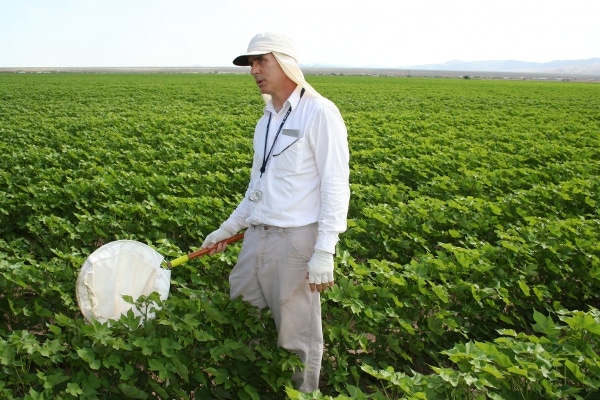
The regular sampling of cotton with a sweep net is one of the most powerful ways to monitor the density of key pests and natural enemies to facilitate critical decision making.Sweep net sampling is subject to individual variation, but the standardization of the sweeping technique can be accomplished so the sweeps results of one pest manager match those of another pest manager.The sweep net should be 15 inches in diameter. A two-handed sweeping motion provides a more consistent and precisely delivered sweep.
July 2, 2012

The regular sampling of cotton with a sweep net is one of the most powerful ways to monitor the density of key pests and natural enemies to facilitate critical decision making.
However, sweep net sampling is not an absolute measure like air temperature with a thermometer. It is subject to individual variation, but the standardization of the sweeping technique can be accomplished so the sweeps results of one pest manager match those of another pest manager.
The sweep net should be 15 inches in diameter. A two-handed sweeping motion provides a more consistent and precisely delivered sweep. A proper grip is similar to a baseball bat grip with one hand on the metal ferrule and the other near the top of the handle.
One sweep is one pass through the entire width of the canopy in the upper 12 inches of the plants in one row.
Any number of sweeps can be taken per subsample, but generally should not exceed 25 or else excessive damage to the insects within can occur. Guidelines are based on 100-sweep totals and thus require information from four 25-sweep subsamples taken from different, randomly-chosen locations within an average-size field.
When sweeping, walk in the furrow along the row. Sweep every few steps so each sweep is through undisturbed canopy.
The goals of a standardized sweep are:
The angle of attack should place the net hoop perpendicular to the ground or slightly open towards the sky when it strikes the central axis or main stem of the cotton plants. A closed angle will throw more insects and plant material to the ground.
The depth of the sweep should capture a volume from the top of the canopy that leaves about three inches of airspace above the canopy (about a fist’s width).
The force of the sweep should be such that 25 sweeps recover some amount of plant material in the sweep bag. A collection of broken terminals and branches indicates too much force; no leaf material indicates too little force. A fist’s worth of plant material should be about right most of the time.
Each variety and growth stage will require some adjustment to the tempo and force of the sweep to accommodate the goals outlined above. Younger plants cannot be struck quite as hard as older ones; older ones can be struck rather vigorously. Sweeping should begin when plants are about 18 inches high.
Once the sweeps are collected, a quick ‘snapping’ motion several times will force all of the net’s contents to the tip of the net where it can be pinched off to prevent insects from escaping. Invert the net and push the pinched-off tip of the net through the opening of the net. Slowly released the grip to allow insects to crawl or fly out.
Note, the presence of pest insects (commonly Lygus bugs, cotton fleahoppers, stink bugs, and various caterpillars), plus many natural enemies (especially Geocoris, Orius, Collops beetles, Coccinellids, and large Hemipteran predators).
Plant material can be slowly lifted out, inspected, and discarded. Once all the plant material is sorted, thoroughly inspect the net seam, using a hand lens if necessary, to note any small Lygus nymphs that may have been trapped at the bottom of the net.
To view this article and the related photos and cut lines in English, click on this link: http://cals.arizona.edu/apmc/docs/SweepsAnatomyv2c.pdf.
The Spanish version of the article with photo cut lines is available at http://cals.arizona.edu/apmc/docs/SweepsAnatomyv2cSpanish.pdf.
You May Also Like



